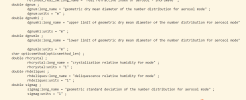ssanyal3@illinois_edu
New Member
Hi,I have outputs of separate aerosols in my history files. How do I calculate the PM2.5 concentration from the separate aerosol species? Swarnali
Dear Alcide,Hi all,
An update on Yuan's comments. CESM1 doesn't output PM2.5 directly, so it needs to be calculated from the species of the chemical mechanism. If you use the Bulk Mode aerosol scheme in CESM,
PM2.5=NH4NO3+SO4+OA+BC+DST01+DST02+SSLT01+SSLT02,
with OA=1.8xOC+SOA, BC=CB1+CB2, OC=OC1+OC2 (which are the hydrophobic and hydrophilic forms).
DST01 and DST02 are dust with diameter < 2.5 um and SSLT01 and SSLT02 are seasalt with diameter < 2.5 um.
Also check what SOA scheme when applicableIf you use CAM3/7, as commented by Yuan above, please refer Table 1 in this paper (Toward a Minimal Representation of Aerosols in Climate Models: Comparative Decomposition of Aerosol Direct, Semidirect, and Indirect Radiative Forcing) for the diameter distribution of aerool particles in the aerosol modes, and sum the mass of all aerosol species up (caution for sea-salt and dust in the Coarse mode, which should be only a part of the integraion). Note that in MAM3/7, sulphate is partly neutralized by ammonium in the form of NH4HSO4 so that ammonium is effectively prescribed and NH3 aerosol is not simulated.
Please feel free to comment/perfect this!
Cheers, Alcide
Dear Anushree,Hi all,
With cesm2.1.1, PM2.5 is now a direct output.But does anyone know about its constituents.Kindly help if you have answers.
Regards,
Anushree
Dear Wang,Alcide, You have to DIY for an accurate calculation of total PM2.5 in MAM3/7. Take MAM3 for example, total PM2.5 is composed of total mass in the Aitken and Accumulation modes and a part from the Coarse mode. To get the coarse part, you need to integrate its log-normal spectrum up to 2.5 micron (size range of coarse mode is typically 0.8 to 3.6). Yuan

